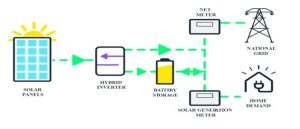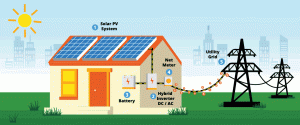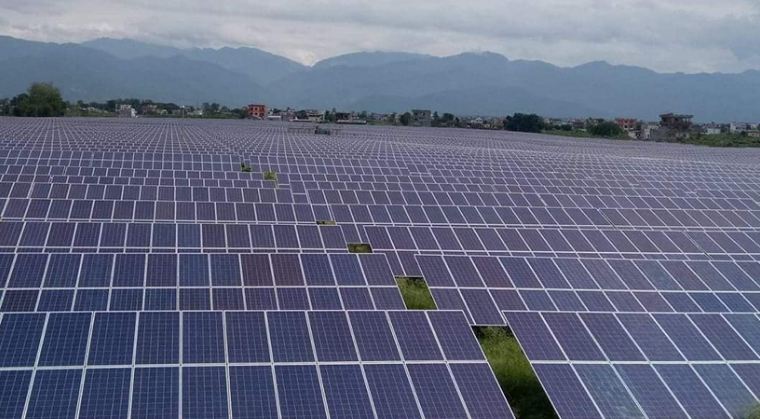RENEWABLE ENERGY

Renewable energy, also called alternative energy, usable from replenishable sources such as the sun (solar energy), wind(wind energy)river(hydroelectric energy), hot springs (geothermal energy), tides (tidal energy), and biomass (biofuels).
Historical Overview
1954 – Daryl Chapin, Calvin Fuller and Gerald Pearson invented a silicon PV cell in Bell’s lab which had 4% efficiency.
1918 – Jan Czochralski discovered a method for production of monocrystalline silicon cell which was constructed in 1941 for the first time.
1883 – Charles Fritts invented first selenium solar cell.
1839 – Edmond Becquerel

Solar Energy
- Solar energy is the energy which is harnessed from the sun energy, causing chemical reaction and generating electricity.
- Solar radiation may be converted directly into electricity by solar cells (photovoltaic cells).
- The single cell generally does produce 2W, while connecting large number of individual cells as in solar panel arrays hundreds and thousands of KW electric energy can be generated.
Solar Panel
- Solar panel works by allowing the photons , or particles of light, to knock electrons free from atoms, generating a flow of electricity.
- Solar panels basically consists many smaller units called photovoltaic cells — this means they convert sunlight into electricity.
Types of solar panel
-
- Monocrystalline: Higher performance and efficiency, Higher cost.

- Polycrystalline: Lower performance, Lower efficiency and lower performance.

- Thin-film: Portable and flexible, Lower performance and lower efficiency.

- Monocrystalline: Higher performance and efficiency, Higher cost.
Charge controller
- Charge controller manages the battery charging process.
- Prevents from overcharging and discharging.
- Charge the battery on the constant basis during over voltage and under voltage situation.
- Helps monitoring the solar panel system.


Battery
Lithium– ion Battery
Pros:
- Stores much higher energy in the less space and discharges all the energy.
- High efficiency.
- Larger lifespan at least of 10 years warranty period.
- Can be installed by any company accurately and safely.
- Mostly used in residential area as, it can hold more energy in smaller space.
- Might easily catch fire but a good installation process can cope this problem easily.
- Expensive.
Lead– acid Battery
Pros:
- Stores the energy for much longer time.
- Highly reliable.
- Cheaper.
Cons:
- Requires ventilation and regular maintenance.
- Low DOD(depth of discharge) that means shorter lifespan around 5-10 years.
Nickel Cadmium battery
Pros:
- Highly durable.
- Doesn’t require complex battery management and are maintenance free.
- Ability to operate at extreme temperature.
Cons:
- Cadmium is highly toxic so couldn’t rule the market.
- Difficult to dispose and recycle.
- Due to memory effect couldn’t hold the charge.
Flow battery
Contains water- based electrolyte that flows between two chambers within the battery and when charged, chemical reaction occurs and that let the energy to be stored and discharged subsequently.
Pros:
- Liquid used is fire retardant so no risk of thermal runway.
- 100% DOD that let us to use all the energy stored in the battery without damaging the battery’s life.
- Longest lifespan of around 30 years.
Cons:
- Highly expensive.
- Larger size.
- Relatively low storage capacity so for higher storage of energy they need to be in bigger size.
Solar Inverter
- Inverter simply convert or invert the direct current produced by panel into alternating current.
- String or central string inverter
- Smaller solar arrays may use this type of inverter.
- DC current produced by the panel and through the circuit harness and finally to the single string inverter .
Pros:
- Easier installation due to fewer parts.
- Least expensive.
- Easier maintenance due to installed in roof as have easier access.
Cons:
- Can limit the power production if complexity in roof design and system.
- Drop in production of single solar panel due to shading can hamper the production of whole string.
Optimized String Inverter
Optimized string inverter has the one power optimizer that let the energy to be optimized to certain threshold and send it to the inverter, which converts the dc power to the ac power.
Pros:
- Consistent power flow to the converter .
- Warranty extended to 25 years.
- Optimize the power production even in the complex roof and system design.
- Enable the power production data and monitoring at individual panel level.
Cons:
- Expensive.
- Some optimized string installed in factory may not be repairable at that time panel needs to be replaced.
Micro Inverter
Micro inverter convert the dc into ac at panel level that is micro inverter is installed at every panel.
Pros:
- Optimization of energy conversion at panel.
- Suitable for complex roof and system design.
- The poor performance of one panel doesn’t hamper the production of entire energy.
- Help to enable the power performance data and monitoring of individual panel.
- Maximum power production even in the shading.
Cons:
- Highly expensive.
- Difficult to repair as they are installed in the roof under the panel.
Hybrid Inverter System
- Multi-mode inverter with a battery backup system.
- Convert the energy from the solar array and battery and the grid before available.
Pros:
- Intelligent and programmable device.
- Can utilize with or without battery backup.
- Time tested in off- grid system.
- All in one system.
Cons:
- Can reduce the energy efficiency.
- Limitation in system design.
Types of Solar Power System
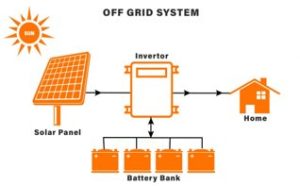 Off- grid solar power system
Off- grid solar power system
- Suitable for the remote areas where there is no access of electricity and where they have to fully depend upon their own.
- Generator backup for supplement production during bad weather condition for long time.
- Battery backup system makes it more expensive.
- Energy consumption can be limited.
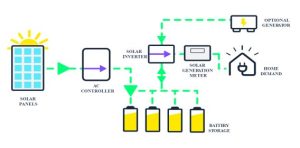
 On- grid solar power system
On- grid solar power system
- Suitable for the remote areas where there is no access of electricity and where they have to fully depend upon their own.
- Generator backup for supplement production during bad weather condition for long time.
- Battery backup system makes it more expensive.
- Energy consumption can be limited.
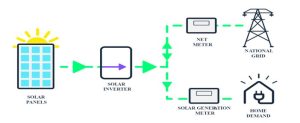
Hybrid Solar Power System
- Have both feature of on-grid and off-grid solar power system.
- Battery backup is there so in case any interruption in the power supply during the bad long stretches in weather condition or at night or any and from the grid, consumer doesn’t need to suffer.
- Net metering is there for the energy calculation for incoming and outgoing energy.
